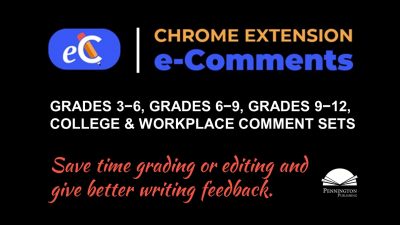Grammar Checkers for Teachers
Conscientious teachers still mark up and comment on student essays. Despite recent trends toward holistic grading and the views of some kind-hearted souls who believe that “red marking” student writing irreparably crushes self-esteem, the vast majority of teachers do respond to student writing. Of this majority, some comment on writing content; some on essay structure; some on the quality and relevance of evidence; some on the proper use of citations; some on grammar and usage; some on mechanics (punctuation, capitalization, spelling, etc.); and some attend to matters of writing style. Rarely does a teacher do it all.
It’s exhausting and time-consuming. So, naturally, teachers look for short-cuts that will save energy and time, but ones which will still give students what they need as developing writers. Enter spell checker and grammar checker software. Whereas spelling checkers, either as a stand-alone software or as a tool embedded in word processing programs such as Microsoft Word®, do a reasonable job of finding spelling errors (other than troublesome homonyms), grammar checkers simply cannot replicate that effectiveness. But there are some helpful resources to lighten the teacher’s load…
Wikipedia has a nice article, Grammar Checker, which explains the programming limitations of grammar checkers, but suffice it to say for non-techies: grammar checking software is a whole lot harder to program than is spelling. My take is that we should encourage students to spell check and revise accordingly, but skip the grammar check and proofread instead. Geoffrey K. Pullum, Professor of General Linguistics at the University of Edinburgh, agrees with greater reservations:
“For the most part, accepting the advice of a computer grammar checker on your prose will make it much worse, sometimes hilariously incoherent. If you want an amusing way to whiling away a rainy afternoon, take a piece of literary prose you consider sublimely masterful and run the Microsoft Word™ grammar checker on it, accepting all the suggested changes.” (Monkeys Will Check Your Grammar, 2007)
 The popular website Top Ten Reviews does a nice job reviewing the four most popular grammar checkers, although their top choice, Grammarly, did happen to advertise rather prominently on their site. In the review site’s testing, Grammarly caught 10 of 14 “grammar” errors. Now, to put on my English teacher’s hat, these were not all grammatical errors, but I nitpick. Of course, I had to try my own writing submission with the Grammarly software:
The popular website Top Ten Reviews does a nice job reviewing the four most popular grammar checkers, although their top choice, Grammarly, did happen to advertise rather prominently on their site. In the review site’s testing, Grammarly caught 10 of 14 “grammar” errors. Now, to put on my English teacher’s hat, these were not all grammatical errors, but I nitpick. Of course, I had to try my own writing submission with the Grammarly software:
To pee, or to pee not: that is not the question. When in the path of alien invasions, it becomes necessary for the rights of the governed to outweigh the rights of the graham crackers, it is the right of the fig newton to abolish that nonsense speak.
The results? I could break down all of the issues, but you get the idea.
So, are there any computer short-cuts for essay response and grading that do help the conscientious teacher in providing quality essay response throughout the writing process? Yes there are, but these must remain where they belong: in the control of the teacher. At present, computer-scored essays remain a pipe dream.
However, a comfortable balance can be struck between technological efficiency and teacher judgment.
Here’s a freebie to add to the Chrome extension toolbar that just might make life a bit easier for teachers this fall: e-Comments Chrome Extension. This free comment insert program for Google docs and slides will save grading time and improve writing feedback. Insert hundreds of customizable Common Core-aligned instructional comments, which identify, explain, and show how to revise writing issues, with just one click from the e-Comments menu. Add your own comments to the menu, including audio, video, and speech-to-text. Includes separate comment banks for grades 3-6, 6-9, 9-12, and AP/College.
*****

Pennington Publishing Grammar Programs
Teaching Grammar, Usage, and Mechanics (Grades 4, 5, 6, 7, 8, and High School) are full-year, traditional, grade-level grammar, usage, and mechanics programs with plenty of remedial practice to help students catch up while they keep up with grade-level standards. Twice-per-week, 30-minute, no prep lessons in print or interactive Google slides with a fun secret agent theme. Simple sentence diagrams, mentor texts, video lessons, sentence dictations. Plenty of practice in the writing context. Includes biweekly tests and a final exam.
Grammar, Usage, and Mechanics Interactive Notebook (Grades 4‒8) is a full-year, no prep interactive notebook without all the mess. Twice-per-week, 30-minute, no prep grammar, usage, and mechanics lessons, formatted in Cornell Notes with cartoon response, writing application, 3D graphic organizers (easy cut and paste foldables), and great resource links. No need to create a teacher INB for student make-up work—it’s done for you! Plus, get remedial worksheets, biweekly tests, and a final exam.
Syntax in Reading and Writing is a function-based, sentence-level syntax program, designed to build reading comprehension and increase writing sophistication. The 18 parts of speech, phrases, and clauses lessons are each leveled from basic (elementary) to advanced (middle and high school) and feature 5 lesson components (10–15 minutes each): 1. Learn It! 2. Identify It! 3. Explain It! (analysis of challenging sentences) 4. Revise It! (kernel sentences, sentence expansion, syntactic manipulation) 5. Create It! (Short writing application with the syntactic focus in different genre).
Get the Diagnostic Grammar, Usage, and Mechanics Assessments, Matrix, and Final Exam FREE Resource:
![]()



